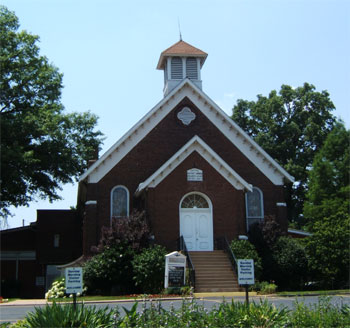Fee Fee Baptist Church
The oldest continually operating protestant church
west of the Mississippi River.
Est. 1807

History of Fee Fee
Two hundred years ago Bridgeton was a land of rolling hills, forests, prairies, springs and rivers. A swamp was where Lambert – St. Louis International Airport is today. Deer and buffalo grazed in the fields while fish and otters swam in the rivers. The land was beautiful and fertile.
Native Americans had lived here for hundreds of years. One of their camps was in Bridgeton’s Matthews Park. Native American pottery and arrowheads may still be found in the Bridgeton area.
The first white people who came here were French. One of them was Nicholas Beaugenou, Jr. Nicholas was known to his friends as Fifi. Americans spelled his nickname the way it was pronounced, “Fee Fee”.
St. Ferdinand was the nearest settlement at the time. Today it is part of the city of Florissant. One Sunday in August 1793 seven people left St. Ferdinand to pick wild plums. Two Native Americans named Red Cedar and Turkey Foot attacked them. Mrs. Riviere and 10 year old Elizabeth Creely escaped by hiding in bushes but the others were killed.
The next year William Owen built a fort for protection. Because of nearby cottonwood trees and swamps his settlement was called Marais de Liards. The name was later changed to Bridgeton.
Most of the early homes were built French style with the logs set on their ends. Most pictures show log cabins built English style with the logs laid horizontally.
Although Spain owned the land west of the Mississippi many Americans settled there. Some of these people were Baptists. They included the Musick, Sullen, Williams, Richardson, Martin, Link, Sullivan, Hildebrands and Howdershell families. Since Spain only allowed Catholic worship, the Baptists were not allowed to worship or form a church.
In the spring of 1798, John Clark came to the Bridgeton area from Illinois to hold Protestant worship services. This was done secretly since it was against Spanish law.
The United States purchased the land west of the Mississippi River in 1803. People here could now worship as they pleased. Thomas Musick, a pastor in Illinois, moved here when he heard about the purchase. In 1807, he and several families formed a Baptist church on the banks of Fee Fee’s creek.
The Early Years
 St. Louis became part of the United States after the Louisiana Purchase in 1803. Over half of the population was infidels who boasted that the Sabbath had never crossed the Mississippi and never would. The first Baptist ministers came to Missouri as foreign missionaries to work among the heathen.
St. Louis became part of the United States after the Louisiana Purchase in 1803. Over half of the population was infidels who boasted that the Sabbath had never crossed the Mississippi and never would. The first Baptist ministers came to Missouri as foreign missionaries to work among the heathen.
In 1807 the Rev. Thomas Musick and a small group of friends met in a home near Fee Fee’s Creek. There they organized a Baptist church. The church met in the homes of members until 1815. That year they built a log house to meet in. Although the pews did not have backs, the people still though that they were comfortable.
In 1830, the log building was replaced by a brick building located on the road from St. Louis to St. Charles. If you go to the Fee Fee Cemetery, you can see this building. This building was shared with Presbyterian and Methodist churches who, with the Baptists, took turns leading the services.
 During the 1860s, when most roads were made of dirt, a portion of the road to St. Charles was relocated and paved with rock . This road is still called the St. Charles Rock Road. The intersection of this road with Fee Fee Road became the center of a growing community later know as Pattonville.
During the 1860s, when most roads were made of dirt, a portion of the road to St. Charles was relocated and paved with rock . This road is still called the St. Charles Rock Road. The intersection of this road with Fee Fee Road became the center of a growing community later know as Pattonville.
The church needed a new meeting house, and they decided to build it on the new road. Erastus Post, one of the church’s deacons, donated land for the building. The new building, which today is called the Chapel, was completed in 1870. The building was in a grove of oak trees, some of which were over a hundred years old. A fence to keep out cattle surrounded the property, and there was an outhouse behind the building.
The Middle Years
 In 1875 John Luther became pastor of the church. His 16 year old daughter Anne taught a girl’s class in Sunday School and played the church organ. Anne felt that God was calling her to be a missionary. After the family moved to Texas, Anne married a young preacher named William Bagby. Anne and William became the first Baptist Missionaries to South America.
In 1875 John Luther became pastor of the church. His 16 year old daughter Anne taught a girl’s class in Sunday School and played the church organ. Anne felt that God was calling her to be a missionary. After the family moved to Texas, Anne married a young preacher named William Bagby. Anne and William became the first Baptist Missionaries to South America.
The late 1800s and early 1900s were difficult years for the church. Conditions improved in 1919 and the church was able to call a full time pastor.
This was still a farming area in 1930, but people were starting to build homes here. The church was growing and more space was needed. During 1948 a new building was constructed behind the chapel.
Current Years
 In 1958 a large three story building was completed. The second and third floors were used for education space while the ground floor was used as a “temporary” auditorium for 17 years.
In 1958 a large three story building was completed. The second and third floors were used for education space while the ground floor was used as a “temporary” auditorium for 17 years.
During the late 1950s and early 1960s, Fee Fee helped established the First Baptist Church of Harvester and Villebrook Baptist Church.
In 1975, a new building containing worship and education space was completed and the “temporary” worship space was converted to preschool space.
The Rev. Wallace Jones, pastor emeritus, served as pastor of Fee Fee Baptist Church for 35 years, from late 1959 until 1994. The only pastor to serve as long was founding pastor Thomas Musick who served from 1807 until late 1842.
The Rev. Randall Fullerton was called as pastor in 1996 and served as pastor of Fee Fee Baptist Church until October 29, 2017. 
The Rev. Zach Crook was called in January 2019 as Senior Pastor of Fee Fee Baptist Church.
